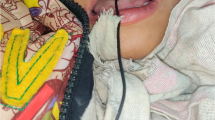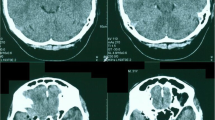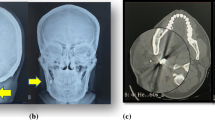Abstract
Introduction
Craniofacial penetrating injuries are not a rare sight in the career of oral and maxillofacial surgeons and trainees, but bizarre craniomaxillofacial sharp injuries caused by peculiar foreign bodies to the head and neck region, complicating and obscuring the vital structures, are seldom found. Foreign bodies such as lunch boxes, wooden branches or twigs are peculiarly associated with penetrating/perforating craniofacial severe impaled injuries with dramatic consequences.
Case Report
Three cases are reported, with elaborate descriptions of the site, kind, and severity of the injuries. Cases 1 and 3, wooden impalement injuries into the neck region and sensitive orbital region, respectively, necessitating immediate surgical retrieval as in both cases. In case 2, 4-year old sustained an injury with a sharp rim of the lunch box, obscuring the entire craniofacial region and impeding the primary care and assessment.
Cases represent the peculiarity of the injuries caused by unusual foreign bodies and how their uniqueness demanded a different surgical intervention.
The need for a multidisciplinary approach is crucial to managing these injuries in areas with a high degree of specialization overlap, such as the craniofacial region.
Conclusion
We give an overview of the diagnosis and treatment of penetrating foreign body trauma encountered in our department. Every foreign body penetrating trauma demands a formulation of a different surgical plan and stands as a challenge for the treating surgeons. Adequate radiology knowledge, detection, vigilant clinical assessment, and tension-free closure are a few of the important aspects for the ideal management of penetrating foreign body trauma.




Similar content being viewed by others
Abbreviations
- GCS:
-
Glasgow Coma Scale
- IED:
-
Improvised explosive devices
- IOF:
-
Infraorbital fissure
- FLAIR:
-
Fluid-attenuated inversion recovery
- ATLS:
-
Advanced trauma life support
- FAST:
-
Focused assessment with sonography for trauma
References
Olusanya AA, Aladelusi TO, Olanloye OM (2015) Experience with impacted foreign bodies in the maxillofacial region at a Nigerian teaching hospital. J West Afr Coll Surg. 5(3):1–15
Dai D, Meyer S, Kaltheuner LC, Plani F (2018) On a knife-edge: clinical uncertainty with an extensive knife blade in situ in the craniofacial region. BMJ Case Rep. https://doi.org/10.1136/bcr-2018-226054
Voss JO, Maier C, Wüster J, Beck-Broichsitter B, Ebker T, Vater J, Dommerich S, Raguse JD, Böning G, Thieme N (2021) Imaging foreign bodies in head and neck trauma: a pictorial review. Insights Imaging 12(1):20. https://doi.org/10.1186/s13244-021-00969-9
de Santana ST, Avelar RL, Melo AR, de Moraes HH, Dourado E (2011) Current approach in the management of patients with foreign bodies in the maxillofacial region. J Oral Maxillofac Surg 69(9):2376–2382. https://doi.org/10.1016/j.joms.2010.10.038
Wolf SJ, Bebarta VS, Bonnett CJ, Pons PT, Cantrill SV (2009) Blast injuries. Lancet 374(9687):405–415. https://doi.org/10.1016/S0140-6736(09)60257-9
Kataria R, Singh D, Chopra S, Sinha VD (2011) Low velocity penetrating head injury with impacted foreign bodies in situ. Asian J Neurosurg 6(1):39–44. https://doi.org/10.4103/1793-5482.85635
Dahiya A, Singh V, Bhagol A, Britto A, Chhikara D (2023) Lunch box penetrating injury in the craniofacial region impedes the primary airway management and surgical intervention. J Maxillofac Oral Surg. 22(2):460–463. https://doi.org/10.1007/s12663-023-01872-0
Wagh V, Tidake P (2022) Clinical study and profile of ocular trauma: findings from a rural hospital in central India. Cureus 14(7):e26915. https://doi.org/10.7759/cureus.26915
Funding
None.
Author information
Authors and Affiliations
Corresponding author
Ethics declarations
Conflict of interest
None.
Informed Consent
Yes.
Consent for Participation
Yes.
Additional information
Publisher's Note
Springer Nature remains neutral with regard to jurisdictional claims in published maps and institutional affiliations.
Rights and permissions
Springer Nature or its licensor (e.g. a society or other partner) holds exclusive rights to this article under a publishing agreement with the author(s) or other rightsholder(s); author self-archiving of the accepted manuscript version of this article is solely governed by the terms of such publishing agreement and applicable law.
About this article
Cite this article
Singh, V., Dahiya, A., Britto, A. et al. Complex-Type Foreign Body Penetrating Injuries of the Craniofacial Region and Surgical Management: A Report of Three Cases. J. Maxillofac. Oral Surg. (2024). https://doi.org/10.1007/s12663-024-02152-1
Received:
Accepted:
Published:
DOI: https://doi.org/10.1007/s12663-024-02152-1




